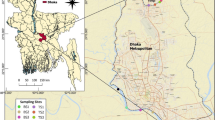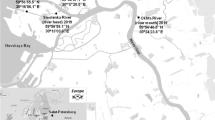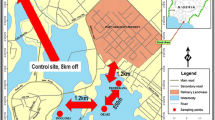Abstract
Freshwater mollusks are employed as bioindicators for the assessment of water quality in biomonitoring studies since the water quality of natural resources is crucial for humans. The freshwater snail species known as Viviparus contectus (Viviparidae: Gastropoda) is one that people eat. Here, the levels of heavy metals (Cd, Cr, Pb, As, Zn, and Cu) in water and V. contectus samples were determined. An Inductively Coupled Plasma Atomic Emission Spectrometer (ICP-AES, Spectro Arcos, vertical plasma) was used for the analysing the heavy metal concentrations in water and freshwater snail samples. The results of the current investigation demonstrated that freshwater snails accumulated metals in their water and soft tissues in the following orders: Pb > Cr = Zn = Cu = Cd = As and Zn > Cu > Pb > Cd > As = Cr. Autumn was the time of year when higher amounts of heavy metals (As, Cr, Cu, Zn, and Hg) were found. Pb content in the freshwater snail samples was strongly impacted by seasonal fluctuations (P 0.05). For adults, the EDI (estimated daily intake) values were lower than the TDI (tolerable daily intake) values, and the HI (hazard index) values were below 1. Freshwater snail samples had Zn and Pb levels that were over the FAO/WHO, Turkish Food Codex, JECFA, and EC limit values. Except for Pb, the water study shows mean metal concentrations below the USEPA, Turkish Pollution Control Regulation, and World Health Organisation maximum allowed levels. Aquatic ecosystems were negatively impacted by anthropogenic activities overall, and this study can provide a helpful data set for investigations on metallic contamination in water bodies and biomonitoring in freshwater ecosystems.


Similar content being viewed by others
Data availability
The data that support the fndings of this study are available from the corresponding author upon reasonable request.
References
Ahluwalia SS, Goyal D (2007) Microbial and plant derived biomass for removal of heavy metals from wastewater. Bioresour Technol 98(12):2243–2257
Aksu Ö, Yabanli M, Can E, Kutluyer F, Kehayias G, Can ŞS, Demir V (2012) Comparison of heavy metals bioaccumulation by Dreissena polymorpha (Pallas, 1771) and Unio elongatulus eucirrus (Bourguignat, 1860) from Keban Dam Lake, Turkey. Fresenius Environ Bull 21(7a):1942–1947
Azizi G, Layachi M, Akodad M, Yáñez-Ruiz DR, Martín-García AI, Baghour M, Moumen A (2018) Seasonal variations of heavy metals content in mussels (Mytilus galloprovincialis) from Cala Iris offshore (Northern Morocco). Mar Pollut Bull 137:688–694
Bilandzic N, Dokic M, Sedak M, Varenina I, Kolanovic BS, Oraic D, Zrncic S (2012) Determination of copper in food of animal origin and fish in Croatia. Food Control 27(2):284–288
Blaise C, Gagne F, Pellerin J, Hansen PD, Trottier S (2002) Molluscan shellfish biomarker study of the Quebec, Canada, Saguenay Fjord with the soft-shell calm, Mya arenaria. Environ Toxicol 17(3):170–186
Blewett TA, Simon RA, Turko AJ, Wright PA (2017) Copper alters hypoxia sensitivity and the behavioural emersion response in the amphibious fish Kryptolebias marmoratus. Aquat Toxicol 189:25–30
Blust R, Ginneken LV, Decleir W (1994) Effect of temperature on the uptake of copper by the brine shrimp, Artemia franciscana. Aquat Toxicol 30:343–356
Bodin N, Burgeot T, Stanisiere JY, Bocquené G, Menard D, Minier C, Boutet I, Amat A, Cherel Y, Budzinski H (2004) Seasonal variations of a battery of biomarkers and physiological indices for the mussel Mytilus galloprovincialis transplanted into the northwest Mediterranean Sea. Comp Biochem Physiol Part C 138(4):411–427
Byrne RH, Kump LR, Cantrell KJ (1988) The influence of temperature and pH on trace metal speciation in seawater. Mar Chem 25:168–181
Cao M, Yao X (2005) Study on extraction technology of taurine from Cipangopaludina chinensis. J Yang Unıv 2:84–87
Catsiki VA, Bei F, Nicolaidou A (1994) Size dependent metal concentrations in two marine gastropod species. Neth J Aquat Ecol 28(2):157–165
Chiu YW, Chen HC, Lee SC, Chen CA (2002) Morphometric analysis of shell and operculum variations in the viviparid snail, Cipangopaludina chinensis (Mollusca: Gastropoda), Taiwan. Zool Stud 41(3):321–331
Chukaeva M, Petrov D (2023) Assessment and analysis of metal bioaccumulation in freshwater gastropods of urban river habitats, Saint Petersburg (Russia). Environ Sci Pollut Res 30(3):7162–7172
Cossa D, Bourget E, Piuze J (1979) Sexual maturation as a source of variation in the relationship between cadmium concentration and body weight of Mytilus edulis L. Mar Pollut Bull 10:174–176
Cui R, Zhao C (1989) Preliminary study on the pharmacological functions of polysaccharides from three mollusca species. J Yunnan Univ Nat Sci 3:172–174
Danabaş D, Kutluyer F, Ural M, Kocabaş M (2018) Metal bioaccumulation in selected tissues of barb (Barbus sp.) and common carp (Cyprinus carpio, Linnaeus 1758) from the Keban Dam Lake, Turkey. Tox Rev 165:78–85
Danabaş D, Kutluyer F, Ural M, Özçelik M, Kocabaş M (2022) Age- and sex-specific bioaccumulation of selected metals in freshwater Mussel (Unio elangatulus eucirrus Bourguignat, 1860) Populating from Keban Dam Lake (Elazig, Turkey). Bull Environ Contam Toxicol 108:366–371
Davies IM, Pirie JM (1980) Evaluation of a mussel watch project for heavy metals in Scottish coastal waters. Mar Biol 57(2):87–93
Depledge MH, Weeks JM, Bjerregaard P (1994) Heavy metals. In: Calow P (ed) Handbook of ecotoxicology. Blackwell Scientific Publications, Oxford, pp 79–105
EC (2006) COMMISSION REGULATION (EU) 2022/617 of 12 April 2022 amending Regulation (EC) No 1881/2006 as regards maximum levels of mercury in fish and salt. https://eur-lex.europa.eu/legal-content/EN/TXT/PDF/?uri=CELEX:32022R0617. Accessed 10.03.2023
FAO/WHO (Food and Agriculture Organization/World Health Organization) (1989) National Research Council Recommended Dietary Allowances, 10th edn. National Academy Press, Washington, DC, USA
FDA (2001) Fish and Fisheries Products Hazards and Controls Guidance, 3rd edn. Department of Health and Human Services, USA
Felagha I, Monanu MO, Amadi BA (2020) Human health risk assessment of heavy metals in three species of Mollusks (Egeria radiata, Limicolaria flammea and Viviparus contectus) from Yenagoa, Bayelsa State, Nigeria. Asian J Adv Res Rep 10(3):21–26
Fisher NS, Reinfelder JR (1995) The trophic transfer of metals in marine systems. In: Tessier A, Turner DR (eds) Metal Speciation and Bioavailability in Aquatic Systems. John Wiley & Sons Ltd, New York, pp 363–406
Fu JF, Zhang RB (2010) Study on inhibitive effect of polysaccharide from Cipangopaludina chinensis gray on Hela cells in vitro. Chin J Nat Med 22:3057–3058
Guerlet E, Ledy K, Meyer A, Giambérini L (2007) Towards a validation of a cellular biomarker suite in native and transplanted zebra mussels: a 2-year integrative field study of seasonal and pollution-induced variations. Aquat Toxicol 81(4):377–388
Javed M, Usmani N (2016) Accumulation of heavy metals and human health risk assessment via the consumption of freshwater fish Mastacembelus armatus inhabiting, thermal power plant effluent loaded canal. Springerplus 5:776
JECFA. Joint FAO/WHO Expert Committee on Food Additives (2011) Evaluation of certain food additives and contaminants. Seventy-third report of the JECFA. WHO Technical Report Series 960 Geneva, Switzerland. Available online at: https://www.inchem.org/documents/jecfa/jecmono/v960je01.pdf. Accessed 10.03.2023
Jiang C, Jiao Y, Chen X, Li X, Yan W, Yu B, Xiong Q (2013) Preliminary characterization and potential hepatoprotective effect of polysaccharides from Cipangopaludina chinensis. Food Chem Toxicol 59:18–25
Jones WG, Walker KF (1979) Accumulation of iron, manganese, zinc and cadmium by the Australian freshwater mussel Velesunio ambiguus (Phillipi) and its potential as a biological monitor. Aust J Mar Freshw Res 30(6):741–751
Jurkiewicz-Karnkowska E (2011) Accumulation of heavy metals in selected gastropod species: lower Bug River and its floodplain water bodies, Ochrona Środowiska i Zasobów Naturalnych Jornal de Pediatria 3(48):316-323
Kader AA, Osman GY, Mohamed AH, Gharieb MM, Ismail NMM, Abdel-motleb A (2016) Bioaccumulation of heavy metals in freshwater snails in relation to lining of water courses in Egypt. J Biosci Appl Res 2:561–573
Kim YS, Kim EK, Don X, Shin WB, Park JS, Kim SJ, Go EA, Byun HG, Park PJ (2019) Antioxidant activities of Viviparus contectus extract against tertbutylhydroperoxide-ınduced oxidative stress. Hu J, et al. (eds.), Taurine. Adv Exp Med Biol 11:1155
Kutluyer Kocabaş F, Kocabaş M (2022) The first record of Viviparus contectus (Millet, 1813) in Demirköprü Dam Lake and evaluation of some biometric parameters. KSU J Agric Nat 25(1):263–269
Langston WJ, Bebianno MJ, Burt GR (1998) Metal handling strategies in molluscs. In: Langston W, Bebianno MJ (eds) Metal metabolism in aquatic environments. Chapman and Hall, London, pp 219–283
Liess M, Gerner NV, Kefford BJ (2017) Metal toxicity affects predatory stream invertebrates less than other functional feeding groups. Environ Pollut 227:505–512
Lu HF, Du LN, Li ZQ, Chen XY, Yang JX (2014) Morphological analysis of the Chinese Cipangopaludina species (Gastropoda; Caenogastropoda: Viviparidae). Zool Res 35(6):510–527
MacFarlane GR, Burchett MD (2000) Cellular distribution of copper, lead and zinc in the grey mangrove, Avicennia marina (Forsk.) Vierh. Aquat Bot 68:45–59
Mahmoud KMA, Abu Taleb HMA (2013) Fresh water snails as bioindicator for some heavy metals in the aquatic environment. Afr J Ecol 51:193–198
Mubiana VK, Blust R (2007) Effects of temperature on scope for growth and accumulation of Cd Co, Cu and Pb by the marine bivalve Mytilus edulis. Mar Environ Res 63:219–235
Namminga HN, Wilhm J (1976) Effects of high discharge and an oil refinery cleanup operation bon heavy metals in water and sediments in Skeleton Creek. Proc Okla Acad Sci 56:133–138
Naveen BP, Mahapatra DM, Sitharam TG, Sivapullaiah PV, Ramachandra TV (2017) Physico-chemical and biological characterization of urban municipal landfill leachate. Environ Pollut 220:1–12
Nriagu JO, Pacyna JM (1988) Quantitative assessment of worldwide contamination of air, water and soils by trace metals. Nature 333:134–139
Orabi O, Khalifa MM (2020) Biota sediment accumulation and bioconcentration factors of trace metals in the snail Melanoides tuberculata form the agricultural drains of the Manzala Lagoon, Egypt. Environ Sci Pollut Res Int 27(15):17754–17761
Özmen H, Külahçı F, Çukurovalı A, Doğru M (2004) Concentrations of heavy metal and radioactivity in surface water and sediment of Hazar lake (Elazığ, Turkey). Chemosphere 55:401–408
Pandiyan J, Asokan S (2015) Habitat use pattern of tidal mud and sand flats by shorebirds (Charadriiformes) wintering in southern India. J Coast Conserv 20:1–11
Pandiyan J, Mahboob S, Govindarajan M, Al-Ghanim KA, Ahmed Z, Al-Mulhm N, Jagadheesan R, Krishnappa K (2021) An assessment of level of heavy metals pollution in the water, sediment and aquatic organisms: A perspective of tackling environmental threats for food security. Saudi J Biol Sci 28(2):1218–1225
Phillips DJH (1976) The common mussel Mytilus edulis as an indicator of pollution by zinc, cadmium, lead and copper. I. Effects of environmental variables on uptake of metals. Mar Biol 38:59–69
Praveena SM, Radojevic M, Abdullah MH, Aris AZ (2008) Application of sediment quality guidelines in the assessment of mangrove surface sediment in Mengkabong lagoon, Sabah, Malaysia. Iran J Environ Health Sci Eng 5(1):35–42
Prueli RJ, Quinn J, Lake JL, Davis WR (1987) Availability of PCBs and PAHs to Mytilus edulis from artificially resuspended sediments. Biol Process Wast Ocean 1:97–108
Rainbow PS (1997) Trace metal accumulation in marine invertebrates:marine biology or marine chemistry? J Mar Biol Assoc U K 77:195–210
Riani E, Cordova MR, Arifin Z (2018) Heavy metal pollution and its relation to the malformation of green mussels cultured in Muara Kamal waters, Jakarta Bay, Indonesia. Mar Pollut Bull 133:664–670
Rouane-Hacene O, Boutiba Z, Belhaouari B, Guibbolini-Sabatier ME, Francour P, Risso-de FC (2015) Seasonal assessment of biological indices, bioaccumulation and bioavailability of heavy metals in mussels Mytilus galloprovincialis from Algerian west coast, applied to environmental monitoring. Oceanologia 57(4):362–374
Rybak A, Messyasz B, Łęska B (2012) Freshwater Ulva (Chlorophyta) as a bioaccumulator of selected heavy metals (Cd, Ni and Pb) and alkaline earth metals (Ca and Mg). Chemosphere 89(9):1066–1076
Saha N, Mollah MZI, Alam MF, Safiur RM (2016) Seasonal investigation of heavy metals in marine fishes captured from the Bay of Bengal and the implications for human health risk assessment. Food Cont 70:110–118
Sharley DJ, Sharp SM, Bourgues S, Pettigrove VJ (2016) Detecting long-term temporal trends in sediment-bound trace metals from urbanised catchments. Environ Poll 219:705–713
Simonato JD, Mela M, Doria HB, Guiloski IC, Randi MAF, Carvalho PSM, Meletti PC, Silva de Assis HC, Bianchini A, Martinez CBR (2016) Biomarkers of waterborne copper exposure in the Neotropical fish Prochilodus lineatus. Aquat Toxicol 170:31–41
Spyra A, Cieplok A, Strzelec M, Babczyńska A (2019) Freshwater alien species Physella acuta (Draparnaud, 1805) - A possible model for bioaccumulation of heavy metals. Ecotoxicol Environ Saf 15(185):109703
Suprapti NH, Bambang AN, Swastawati F, Kurniasih RA (2016) Removal of heavy metals from a contaminated Green Mussel [Perna Viridis (Linneaus, 1758)] using acetic acid as chelating agents. Aquat Procedia 7:154–159
Tekin-Özan S, Kir İ (2008) Seasonal variations of heavy metals in some organs of carp (Cyprinus carpio L., 1758) from Beyşehir Lake (Turkey). Environ Monit Assess 138:201–206
Turkish Food Codex (2002) Fisheries regulations. Official gazette, Addition 7, Ankara, Turkey. Number 24936. Turkish Pollution Control Regulation, (2004). https://www.mevzuat.gov.tr/mevzuat?MevzuatNo=7221&MevzuatTur=7&MevzuatTertip=5. Accessed 10.03.2023
TURKSTAT (2021) Fisheries statistics (2019). Turkish Statistical Institute, Ankara
USEPA (2000) Risk based concentration table. United States Environmental Protection Agency, Philadelphia, Washington DC
USEPA National Recommended Water Quality Criteria – Aquatic Life Criteria (2017) Available from: https://www.epa.gov/wqc/national-recommended-water-quality-criteria-aquatic-lifecriteriatable
Varol M, Sünbül MR (2018) Biomonitoring of trace metals in the Keban Dam Reservoir (Turkey) using mussels (Unio elongatulus eucirrus) and crayfish (Astacus leptodactylus). Biol Trace Elem Res 185(1):216–224
Vukašinović-Pešić V, Blagojević N, Vukanović SB, Savić A, Pešić V (2017) Heavy Metal concentrations in different tissues of the snail Viviparus mamillatus (Küster, 1852) from lacustrine and riverine environments in Montenegro. Turk J Fish Aquat Sci 17:557–563
WHO (2011) World Health Organization. Guidelines for drinkingwater quality. 4th ed. WHO Library Cataloguing-in-Publication Data, Available from: https://www.who.int/publicationsdetail-redirect/9789241549950. Accessed 10.03.2023
Yabanli M, Alparslan Y (2015) Potential health hazard assessment in terms of some heavy metals determined in demersal fishes caught in eastern Aegean Sea. Bull Environ Contam Toxicol 95:494–498
Yabanlı M, Yozukmaz A, Alparslan Y, Acar Ü (2014) Evaluation of heavy metals and selenium contents in the muscle tissues of rainbow trout (Oncorhynchus mykiss Walbaum, 1792) in Western Anatolia. J Food, Agr Environ 12:165–168
Yaman M, Karaaslan NM, Yaman IH (2014) Seasonal variations in toxic metal levels of two fish species, Mugil cephalus and Mullus barbatus and estimation of risk for children. Bull Environ Contam Toxicol 93:344–349
Yap CK, Cheng WH (2013) Distributions of heavy metal concentrations in different tissues of the mangrove snail Nerita lineata. Sains Malays 42(5):597–603
Yap CK, Mohd Ruszaidi S, Cheng WH (2010) Different tissues of rock oyster Saccostrea cucullata as biomonitors of trace metal bio availabilities in the Penang coastal waters, Malaysia. Res J Chem Environ 14(3):17–21
Yap CK, Cheng WH, Karami A, Ismail A (2016) Health risk assessments of heavy metal exposure via consumption of marine mussels collected from anthropogenic sites. Sci Total Environ 553:285–296
Yilmaz AB (2005) Comparison of heavy metal levels of grey mullet (Mugil cephalus L.) and sea bream (Sparusm aurata L.) caught in Iskenderun Bay (Turkey). Turkish J Vet Anim Sci 29:257–262
Yozukmaz A, Yabanli M, Sel F (2018) Heavy metal bioaccumulation in Enteromorpha intestinalis, (L.) Nees, a macrophytic algae: the example of Kadin Creek (Western Anatolia). Braz Arch Biol Technol 61:e18160777
Zhang Y, Luo J, Zhang H, Li T, Xu H, Sun Y, Gu X, Hu X, Gao B (2022) Synthesis and adsorption performance of three-dimensional gels assembled by carbon nanomaterials for heavy metal removal from water: A review. Sci Total Environ 852:158201
Funding
This work was supported by Scientific Research Project Coordination Unit of Munzur University (Project number: YLMUB021-23) and summarized from Emsiye GÖKTÜRK AKSU’s master thesis.
Author information
Authors and Affiliations
Contributions
Conceptualization, supervision and writing were performed by Filiz KUTLUYER KOCABAŞ, investigation were performed by Emsiye GÖKTÜRK AKSU, sampling and analysis were performed by Mehmet KOCABAŞ.
Corresponding author
Ethics declarations
Ethical approval and consent to participate
Not applicable.
Consent for publication
Not applicable.
Competing interests
The authors declare no competing interests.
Additional information
Responsible Editor: Philippe Garrigues
Publisher's note
Springer Nature remains neutral with regard to jurisdictional claims in published maps and institutional affiliations.
Rights and permissions
Springer Nature or its licensor (e.g. a society or other partner) holds exclusive rights to this article under a publishing agreement with the author(s) or other rightsholder(s); author self-archiving of the accepted manuscript version of this article is solely governed by the terms of such publishing agreement and applicable law.
About this article
Cite this article
KUTLUYER KOCABAŞ, F., GÖKTÜRK AKSU, E. & KOCABAŞ, M. Evaluation of metal pollution related to human health risk in freshwater snail Viviparus contectus (Millet, 1813) as a potential bioindicator species in Lake Habitat (Turkey). Environ Sci Pollut Res 30, 93686–93696 (2023). https://doi.org/10.1007/s11356-023-29062-y
Received:
Accepted:
Published:
Issue Date:
DOI: https://doi.org/10.1007/s11356-023-29062-y




